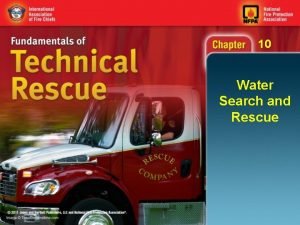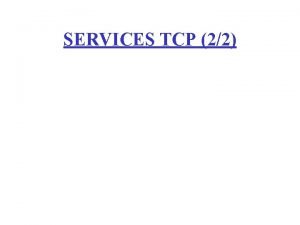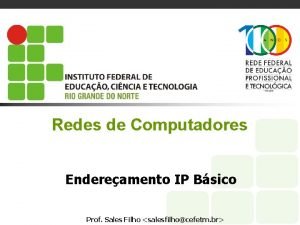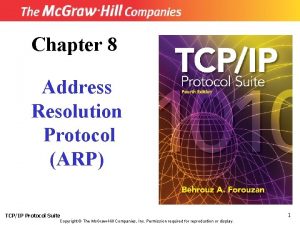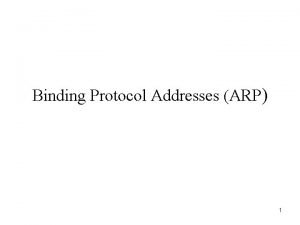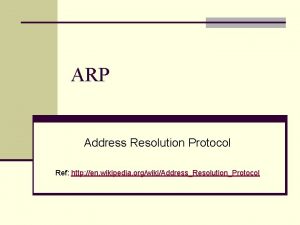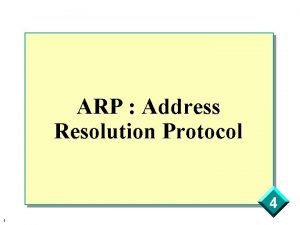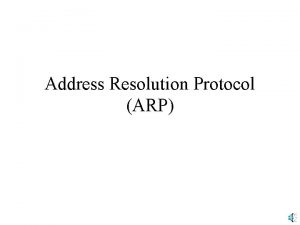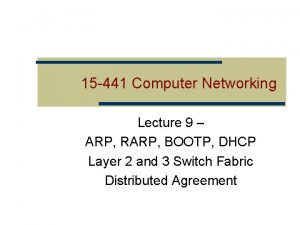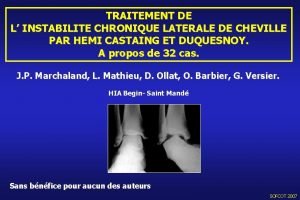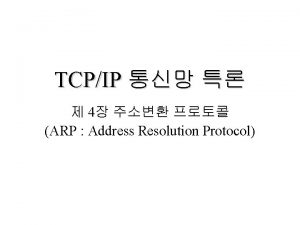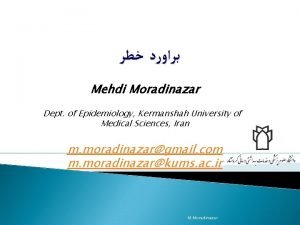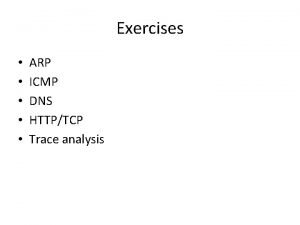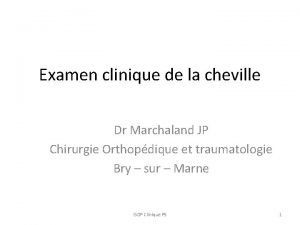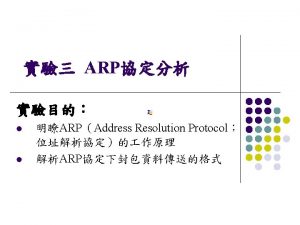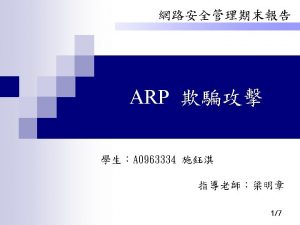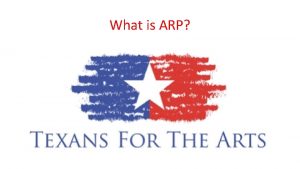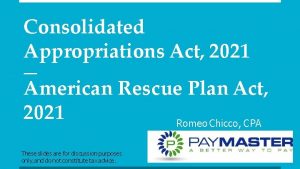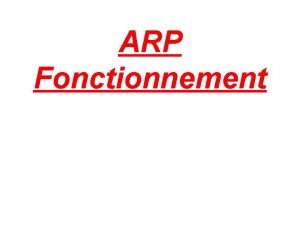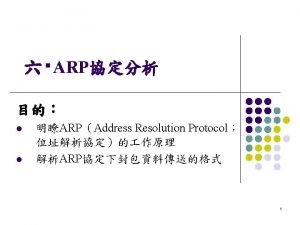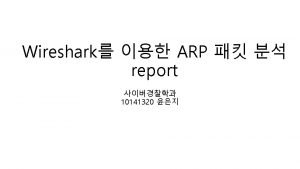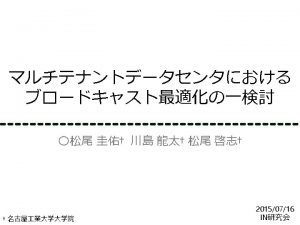ARP Act American Rescue Plan ARP Act March























- Slides: 23

ARP Act American Rescue Plan (ARP) Act March 26, 2021 1

ESSER III Overview • $122. 8 billion through SEAs by Title I formula – 10% SEA set-aside; required SEA reservations: • At least 5% to address learning loss • At least 1% for summer enrichment programs • At least 1% for comprehensive afterschool programs • Up to 2. 5% for “emergency needs as determined by the SEA to address issues responding to the coronavirus, which may be addressed through the use of grants and contracts” • Up to. 5% for SEA administration – 90% to LEAs for enumerated uses, any use allowable under ESEA, IDEA, AEFLA, Perkins • 20% reservation to address learning loss – Funds available for obligation through September 30, 2024 2

ARP DOE Goal • DOE is committed to supporting swift, strategic, effective planning and spending – ESSER I – III funds are not Title I dollars; much more flexible – Staggered periods of availability (2022, 2023, 2024) – Alignment with other funds (federal, state, and local) – Avoid the “cliff” experienced during ARRA 3

ESSER III Funds Total Award: $411, 303, 280 • 10% Set Aside $41, 130, 328 Includes: – 1% - $4, 113, 032. 80 - Summer Enrichment Program – 1% - $4, 113, 032. 80 - Comprehensive Afterschool Program – 5% - $20, 565, 164 - Interventions to Address Learning Loss – 3% - $12, 339, 098. 40 - DOE Initiatives (Including 1/2 of 1% - admin - 2, 056, 516) • Amount for allocation to districts - $370, 172, 954 (90% of total award) 4

Summer Enrichment Program $4, 113, 032. 80 • Make available CTE, Adult Education, and K-12 programming statewide during Summer of 2021 • Create a workforce development resource mapping directory which includes qualified educators statewide to provide coursework and provide PD to educators – Allow more opportunities to students by utilizing a regional approach – Extended Learning Experiences (ELE) to allow students to experience regional opportunities • Leverage community partnerships to provide summer programming (utilizing a whole child approach) and support for students and families statewide 5

Summer Enrichment Program (cont. ) $4, 113, 032. 80 • Fingerprint college students/student teachers to have a summer school teaching experience under the mentorship of a certified Maine teacher – College students may also provide summer programming prior, during, and after summer food service programming for students – Partner with Maine’s popular summer camps that may experience more limited interested during the pandemic • Send a teacher to “campfire PD” • Make summer programming available to students 6

Comprehensive Afterschool Program $4, 113, 032. 80 Support extended learning opportunities for students by: • ensuring all students are provided exposure to trades and available careers • providing PD to teachers regarding Extended Learning Opportunities (ELO) – Expand DOE’s role in supporting ELOs (ELO week, DOE staff support) 7

Interventions to Address Learning Loss $20, 565, 164 – Highlight the universal supports that will be available for all students; • DOE providing resources and training to ensure that all classrooms are inclusively designed (meeting needs of students – Focusing efforts on general educators, specialists, ed tech – Statewide commitment to creating college and career plans for all students in the classes of 2022 and 2023 8

DOE Initiatives (including admin) $12, 339, 098. 40 • Provide teachers with opportunities over the summer to share ideas and refresh; • Train and coach pre-service teachers (community college and university) 9

20% LEA Learning Loss • Allowable uses are broadly defined by USED – May occur during the school day – SEA may provide guidance and resources 10

Elementary and Secondary School Emergency Relief (ESSER) III Fund ESSER I, II, and III may be used for preventing, preparing for, and responding to the COVID-19 pandemic. More specifically, • enable SEAs to enact appropriate measures to help schools implement mitigation strategies consistent with the Centers for Disease Control and Prevention’s (CDC) Operational Strategy for K-12 Schools to the greatest extent practicable • address the many impacts of COVID-19 on students, including from interrupted instruction; • implement strategies to meet students’ social, emotional, mental health, and academic needs; offer crucial evidence-based summer, afterschool, and other extended learning and enrichment programs; • support early childhood education; invest in staff capacity; • and avoid devastating layoffs, ensuring that all students have access to teachers, counselors, and other school personnel to support their needs. 11

ESSER III Clarifications 12

Safe Return to School Plan ESSER III requires SAUs to have a plan for the safe return to in-person instruction and continuity of services. SAUs must have sought and incorporated public comment on the plans. The Maine DOE will provide an opportunity for SAUs to use the plans that were approved in summer or fall of 2020 by local school boards in their applications for ESSER III funds. 13

ESSER III Application • Maine DOE is currently completing internal financial requirements needed to allocate ESSER III funds to eligible school administrative units • DOE’s Consolidated Application and Grant Reimbursement website will be utilized by school administrative districts to complete the ESSER III application and submit reimbursement requests • SEA completed impact study is required • DOE received 2/3 ($274, 202, 188. 00) of the ESSER III award on March 24, 2021. USED will release an application for the remaining 1/3 in April. DOE will not be able to make the required allocations (90% of total award) until the final 1/3 GAN is received. 14

ESSER Timeline • Approved COVID-19 ESSERF project expenses, which were encumbered on or after March 13, 2020 and served to address specific challenges brought on by COVID-19, are eligible for reimbursement • SAUs will have until September 30, 2022 to obligate ESSER I September 30, 2023 to obligate ESSER II, September 30, 2024 to obligate for ESSER III 15

ESSER III Application Approval Process • Maine DOE Application Website: https: //www. 4 pcamaine. org/ • To receive the SAU’s allocation under the ESSER program, a Superintendent must submit to the Department an application that provides the following information: – Part 1: A completed application cover sheet – Part 2: Education Reform, Certifications, Accountability, Transparency, and Reporting and Other Assurances – Part 3: A description of how the SAU intends to use the funds in reasonable and necessary ways to address challenges incurred because of COVID-19. • Grant Award Notification 16

Maintenance of Effort - ARP (FY 22, 23) • State must maintain support of elementary and secondary and higher education at least at the proportionate levels of support relative to overall spending, averaged over FY 17 -19. • ESSER I and ESSER II also have MOE requirements – All are waivable “for the purpose of relieving fiscal burdens incurred by states” in addressing COVID. • ESEA, IDEA also have MOE requirements. 17

State Maintenance of Equity - ARP (FY 22, 23) • State may not disproportionately reduce state funding per pupil for “high-need LEAs” (highest % of low-income students, collectively serving at least 50% of all students in state) • State may not reduce state funding below FY 19 levels for “highest poverty LEAs” (highest % of low-income students, collectively serving at least 20% of students) 18

LEA Maintenance of Equity - ARP • LEA may not disproportionately reduce per-pupil funding or perpupil FTE in a high-poverty school (top 25% of schools based on % of low -income students) • Exceptions to LEA Maintenance of Equity requirements: – – LEA enrollment in the given year is less than 1, 000 students LEA only operates a single school LEA serves all students within each grade span within a single school LEA experiences an unpredictable changes in student enrollment or a precipitous decline in the financial resources, as determined by the Secretary of Education. 19

Maintenance of Effort - CRSSA Under the CRRSA Act, a State that receives ESSER II funds must maintain support for elementary and secondary education and higher education in FY 2022 based on the proportional share of the State’s support for elementary and secondary education and higher education relative to the State’s overall spending averaged over FYs 2017, 2018, and 2019 20

Maintenance of Effort - CARES Elementary and Secondary Education Requirement: A State must maintain support for elementary and secondary education in each of the fiscal years 2020 and 2021 at least the level of such support that is the average of the support for elementary and secondary education provided in the three fiscal years preceding the date of enactment of the CARES Act (FYs 2017, 2018, 2019) 21

ESSER Financial Recording ESSER I Fund 2605, Revenue 4531 ESSER II Fund 2614, Revenue 4531 ESSER III Fund 2615, Revenue 4531 ESSER II funds must be tracked separately from ESSER I Funds Model Chart of Accounts 22

Fiscal Implications of Costs • Personnel paid with ESSER funds – The employer retirement cost and administrative operating expenses related to the retirement programs applicable to those teachers whose funding is provided from federal grants or through federal reimbursement must be paid by local school systems from those federal funds. • Costs reflected in the ED 279 – Special education, career & technical education, gifted & talented, transportation, approved bus purchases • Requirements for federal funds – Time & Effort requirement for personnel – Tracking of equipment & disposition – Federal procurement requirements 23
 Tension diagonal swift water rescue
Tension diagonal swift water rescue Anthem of poland
Anthem of poland Act 1 act 2 act 3
Act 1 act 2 act 3 Arp
Arp Arp 4761
Arp 4761 Tabela arp
Tabela arp Tabela arp
Tabela arp Larp logiciel
Larp logiciel Il ritratto di tristan tzara
Il ritratto di tristan tzara Arp protocol in tcp/ip
Arp protocol in tcp/ip Reverse arp lookup
Reverse arp lookup Arp cache poisoning attack fix
Arp cache poisoning attack fix Arp and rarp in computer networks
Arp and rarp in computer networks Hans arp wiki
Hans arp wiki Arp reply format
Arp reply format Arp internet
Arp internet Arp rarp
Arp rarp Reverse arp
Reverse arp Varus arp
Varus arp Address cont.
Address cont. Arp net
Arp net Arp
Arp Arp exercise
Arp exercise Ligament tibio fibulaire
Ligament tibio fibulaire
